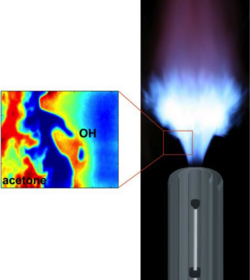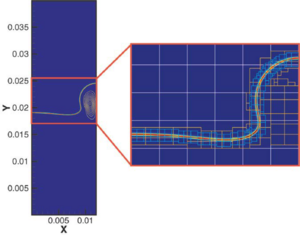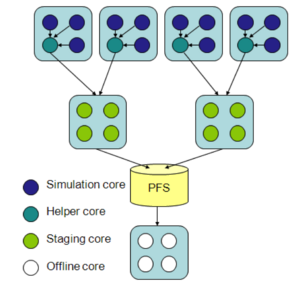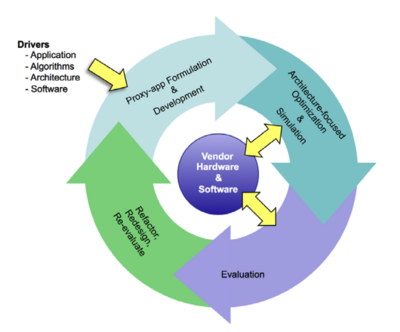ExaCT: Difference between revisions
From Modelado Foundation
imported>Cdenny Blanked the page |
imported>Cdenny No edit summary |
||
| (2 intermediate revisions by the same user not shown) | |||
| Line 1: | Line 1: | ||
{{Infobox Co-design | |||
|name = ExaCT | |||
|image = [[File:ExaCTWebBanner.jpg|400px]] | |||
|imagecaption = | |||
|developer = [http://www.lbl.gov/ LBNL], [http://www.sandia.gov/ SNL], [http://www.lanl.gov/ LANL], [http://www.ornl.gov/ ORNL], [https://www.llnl.gov/ LLNL], [http://www.nrel.gov/ NREL], [http://www.rutgers.edu/ Rutgers U.], [https://www.utexas.edu/ UT Austin], [http://www.gatech.edu/ Georgia Tech], [http://www.stanford.edu/ Standford U.], [http://www.utah.edu/ U. of Utah] | |||
|latest_release_version = version x.y.z | |||
|latest_release_date = Latest Release Date here | |||
|operating_system = Linux, Unix, etc. | |||
|genre = Computational Chemistry? | |||
|license = Open Source or else? | |||
|website = [http://exactcodesign.org http://exactcodesign.org] | |||
}} | |||
== Introduction == | |||
=== Physics of Gas-Phase Combustion represented by PDE’s === | |||
[[File:ExaCT-Gas-Phase-Combustion.png|right|250px]] | |||
* Focus on gas phase combustion in both compressible and low-Mach limits | |||
* Fluid mechanics | |||
** Conservation of mass | |||
** Conservation of momentum | |||
** Conservation of energy | |||
* Thermodynamics | |||
** Pressure, density, temperature relationships for multicomponent mixtures | |||
* Chemistry | |||
** Reaction kinetics | |||
* Species transport | |||
** Diffusive transport of different chemical species within the flame | |||
=== Code Base === | |||
* S3D | |||
** Fully compressible Navier Stokes | |||
** Eighth-order in space, fourth order in time | |||
** Fully explicit, uniform grid | |||
** Time step limited by acoustics / chemical time scales | |||
** Hybrid implementation with MPI + OpenMP | |||
** Implemented for Titan at ORNL using OpenACC | |||
* LMC | |||
** Low Mach number formulation | |||
** Projection-based discretization strategy | |||
** Second-order in space and time | |||
** Semi-implicit treatment of advection and diffusion | |||
** Time step based on advection velocity | |||
** Stiff ODE integration methodology for chemical kinetics | |||
** Incorporates block-structured adaptive mesh refinement | |||
** Hybrid implementation with MPI + OpenMP | |||
* Target is computational model that supports compressible and low Mach number AMR simulation with integrated UQ | |||
=== Adaptive Mesh Refinement === | |||
[[File:ExaCT-AMR.png|right|300px]] | |||
* Need for AMR | |||
** Reduce memory | |||
** Scaling analysis – For explicit schemes flops scale with memory ^ 4/3 | |||
* Block-structured AMR | |||
** Data organized into logically-rectangular structured grids | |||
** Amortize irregular work | |||
** Good match for multicore architectures | |||
* AMR introduces extra algorithm issues not found in static codes | |||
** Metadata manipulation | |||
** Regridding operations | |||
** Communications patterns | |||
=== Preliminary Observations === | |||
* Need to rethink how we approach PDE discretization methods for multiphysics applications | |||
** Exploit relationship between scales | |||
** More concurrency | |||
** More locality with reduced synchronization | |||
** Less memory / FLOP | |||
** Analysis of algorithms has typically been based on a performance = FLOPS paradigm – can we analyze algorithms in terms of a more realistic performance model | |||
* Need to integrate analysis with simulation | |||
** Combustion simulations are data rich | |||
** Writing data to disk for subsequent analysis is currently near infeasibility | |||
** Makes simulation look much more like physical experiments in terms of methodology | |||
* Current programming models are inadequate for the task | |||
** We describe algorithms serially and add things to express parallelism at different levels of the algorithm | |||
** We express codes in terms of FLOPS and let the compiler figure out the data movement | |||
** Non-uniform memory access is already an issue but programmers can’t easily control data layout | |||
* Need to evaluate tradeoffs in terms of potential architectural features | |||
=== How Core Numerics Will Change === | |||
* Core numerics | |||
** Higher-order for low Mach number formulations | |||
** Improved coupling methodologies for multiphysics problems | |||
** Asynchronous treatment of physical processes | |||
* Refactoring AMR for the exascale | |||
** Current AMR characteristics | |||
*** Global flat metadata | |||
*** Load-balancing based on floating point work | |||
*** Sequential treatment of levels of refinement | |||
** For next generation | |||
*** Hierarchical, distributed metadata | |||
*** Consider communication cost as part of load balancing for more realistic estimate of work (topology aware) | |||
*** Regridding includes cost of data motion | |||
*** Statistical performance models | |||
*** Alternative time-stepping algorithm – treat levels simultaneously | |||
=== Data Analysis === | |||
[[File:ExaCT-Data-Analysis.png|right|300px]] | |||
* Current simulations produce 1.5 Tbytes of data for analysis at each time step (Checkpoint data is 3.2 Tbytes) | |||
** Archiving data for subsequent analysis is currently at limit of what can be done | |||
** Extrapolating to the exascale, this becomes completely infeasible | |||
* Need to integrate analysis with simulation | |||
** Design the analysis to be run as part of the simulation definition | |||
*** Visualizations | |||
*** Topological analysis | |||
*** Lagrangian tracer particles | |||
*** Local flame coordinates | |||
*** Etc. | |||
* Approach based on hybrid staging concept | |||
** Incorporate computing to reduce data volume at different stages along the path from memory to permanent file storage | |||
== Co-design Process == | |||
[[File:ExaCT-Co-design_Process.png|right|400px]] | |||
* Identify key simulation element | |||
** Algorithmic | |||
** Software | |||
** Hardware | |||
* Define representative code (proxy app) | |||
* Analytic performance model | |||
** Algorithm variations | |||
** Architectural features | |||
** Identify critical parameters | |||
* Validate performance with hardware simulators/measurements | |||
* Document tradeoffs | |||
** Input to vendors | |||
** Helps define programming model requirements | |||
* Refine and iterate | |||
== Applications == | |||
=== Proxy Applications === | |||
* Caveat | |||
** Proxy apps are designed to address a specific co-design issue. | |||
** Union of proxy apps is not a complete characterization of application | |||
** Anticipated methodology for exascale not fully captured by current full applications | |||
* Proxies | |||
** Compressible Navier Stokes without species | |||
*** Basic test for stencil operations, primarily at node level | |||
*** Coming soon – generalization to multispecies with reactions (minimalist full application) | |||
** Multigrid algorithm – 7 point stencil | |||
*** Basic test for network issues | |||
*** Coming soon – denser stencils | |||
** Chemical integration | |||
*** Kernel test for local, computationally intense kernel | |||
** Others coming soon | |||
*** Integrated UQ kernels | |||
*** Skeletal model of full workflow | |||
*** Visualization / analysis proxy apps | |||
=== Visualization/Topology/Statistics Proxy Applications === | |||
* Proxies are algorithms with flexibility to explore multiple execution models | |||
** Multiple strategies for local computation algorithms | |||
** Support for various merge/broadcast communication patterns | |||
* Topological analysis | |||
** Three phases (local compute/communication/feature-based statistics) | |||
** Low/no flops, highly branching code | |||
** Compute complexity is data dependent | |||
** Communication load is data dependent | |||
** Requires gather/scatter of data | |||
* Visualization | |||
** Two phases (local compute/image compositing) | |||
** Moderate FLOPS | |||
** Compute complexity is data dependent | |||
** Communication load is data dependent | |||
** Requires gather | |||
* Statistics | |||
** Two phases (local compute/aggregation) | |||
** Compute is all FLOPs | |||
** Communication load is constant and small | |||
** Requires gather, optional scatter of data | |||
== Kernel Use == | |||
== Description == | |||
== Download == | |||
Latest revision as of 16:47, February 13, 2013
| ExaCT | |
|---|---|
| Developer(s) | LBNL, SNL, LANL, ORNL, LLNL, NREL, Rutgers U., UT Austin, Georgia Tech, Standford U., U. of Utah |
| Stable Release | version x.y.z/Latest Release Date here |
| Operating Systems | Linux, Unix, etc. |
| Type | Computational Chemistry? |
| License | Open Source or else? |
| Website | http://exactcodesign.org |
Introduction
Physics of Gas-Phase Combustion represented by PDE’s

- Focus on gas phase combustion in both compressible and low-Mach limits
- Fluid mechanics
- Conservation of mass
- Conservation of momentum
- Conservation of energy
- Thermodynamics
- Pressure, density, temperature relationships for multicomponent mixtures
- Chemistry
- Reaction kinetics
- Species transport
- Diffusive transport of different chemical species within the flame
Code Base
- S3D
- Fully compressible Navier Stokes
- Eighth-order in space, fourth order in time
- Fully explicit, uniform grid
- Time step limited by acoustics / chemical time scales
- Hybrid implementation with MPI + OpenMP
- Implemented for Titan at ORNL using OpenACC
- LMC
- Low Mach number formulation
- Projection-based discretization strategy
- Second-order in space and time
- Semi-implicit treatment of advection and diffusion
- Time step based on advection velocity
- Stiff ODE integration methodology for chemical kinetics
- Incorporates block-structured adaptive mesh refinement
- Hybrid implementation with MPI + OpenMP
- Target is computational model that supports compressible and low Mach number AMR simulation with integrated UQ
Adaptive Mesh Refinement

- Need for AMR
- Reduce memory
- Scaling analysis – For explicit schemes flops scale with memory ^ 4/3
- Block-structured AMR
- Data organized into logically-rectangular structured grids
- Amortize irregular work
- Good match for multicore architectures
- AMR introduces extra algorithm issues not found in static codes
- Metadata manipulation
- Regridding operations
- Communications patterns
Preliminary Observations
- Need to rethink how we approach PDE discretization methods for multiphysics applications
- Exploit relationship between scales
- More concurrency
- More locality with reduced synchronization
- Less memory / FLOP
- Analysis of algorithms has typically been based on a performance = FLOPS paradigm – can we analyze algorithms in terms of a more realistic performance model
- Need to integrate analysis with simulation
- Combustion simulations are data rich
- Writing data to disk for subsequent analysis is currently near infeasibility
- Makes simulation look much more like physical experiments in terms of methodology
- Current programming models are inadequate for the task
- We describe algorithms serially and add things to express parallelism at different levels of the algorithm
- We express codes in terms of FLOPS and let the compiler figure out the data movement
- Non-uniform memory access is already an issue but programmers can’t easily control data layout
- Need to evaluate tradeoffs in terms of potential architectural features
How Core Numerics Will Change
- Core numerics
- Higher-order for low Mach number formulations
- Improved coupling methodologies for multiphysics problems
- Asynchronous treatment of physical processes
- Refactoring AMR for the exascale
- Current AMR characteristics
- Global flat metadata
- Load-balancing based on floating point work
- Sequential treatment of levels of refinement
- For next generation
- Hierarchical, distributed metadata
- Consider communication cost as part of load balancing for more realistic estimate of work (topology aware)
- Regridding includes cost of data motion
- Statistical performance models
- Alternative time-stepping algorithm – treat levels simultaneously
- Current AMR characteristics
Data Analysis

- Current simulations produce 1.5 Tbytes of data for analysis at each time step (Checkpoint data is 3.2 Tbytes)
- Archiving data for subsequent analysis is currently at limit of what can be done
- Extrapolating to the exascale, this becomes completely infeasible
- Need to integrate analysis with simulation
- Design the analysis to be run as part of the simulation definition
- Visualizations
- Topological analysis
- Lagrangian tracer particles
- Local flame coordinates
- Etc.
- Design the analysis to be run as part of the simulation definition
- Approach based on hybrid staging concept
- Incorporate computing to reduce data volume at different stages along the path from memory to permanent file storage
Co-design Process

- Identify key simulation element
- Algorithmic
- Software
- Hardware
- Define representative code (proxy app)
- Analytic performance model
- Algorithm variations
- Architectural features
- Identify critical parameters
- Validate performance with hardware simulators/measurements
- Document tradeoffs
- Input to vendors
- Helps define programming model requirements
- Refine and iterate
Applications
Proxy Applications
- Caveat
- Proxy apps are designed to address a specific co-design issue.
- Union of proxy apps is not a complete characterization of application
- Anticipated methodology for exascale not fully captured by current full applications
- Proxies
- Compressible Navier Stokes without species
- Basic test for stencil operations, primarily at node level
- Coming soon – generalization to multispecies with reactions (minimalist full application)
- Multigrid algorithm – 7 point stencil
- Basic test for network issues
- Coming soon – denser stencils
- Chemical integration
- Kernel test for local, computationally intense kernel
- Others coming soon
- Integrated UQ kernels
- Skeletal model of full workflow
- Visualization / analysis proxy apps
- Compressible Navier Stokes without species
Visualization/Topology/Statistics Proxy Applications
- Proxies are algorithms with flexibility to explore multiple execution models
- Multiple strategies for local computation algorithms
- Support for various merge/broadcast communication patterns
- Topological analysis
- Three phases (local compute/communication/feature-based statistics)
- Low/no flops, highly branching code
- Compute complexity is data dependent
- Communication load is data dependent
- Requires gather/scatter of data
- Visualization
- Two phases (local compute/image compositing)
- Moderate FLOPS
- Compute complexity is data dependent
- Communication load is data dependent
- Requires gather
- Statistics
- Two phases (local compute/aggregation)
- Compute is all FLOPs
- Communication load is constant and small
- Requires gather, optional scatter of data